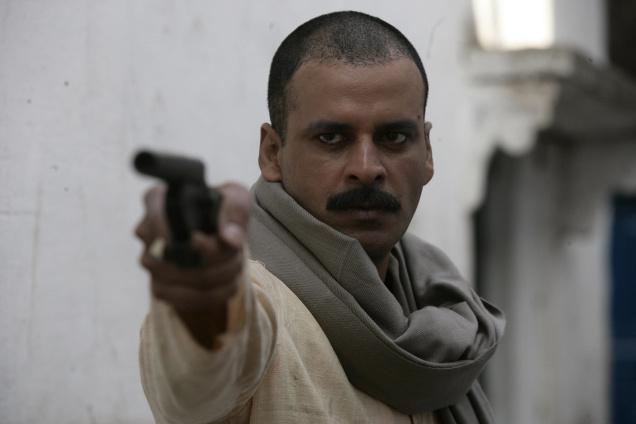
A scene from "Gangs of Wasseypur".
A thoroughly New York affair, the 12th NYIFF showcased contemporary Indian cinema in all its bewildering diversity, from ‘Aadukalam' to Anurag Kashyap.
The mix is indeed a compelling one: A Rabindranath Tagore tale by the iconic Rituparno Ghosh and one-minute cell phone Bollywood films; Anurag Kashyap's “The Gangs of Wasseypur”, which won acclaim at Cannes, and short films made by unknown students from Mira Nair's Maisha Film Lab in Uganda.
Big and small, celebrities and novices, they were all there at the New York Indian Film Festival, with over 44 independent films, documentaries, in a cacophony of languages, a celebration of the many avatars of Indian cinema. The festival, in its 12th year and the oldest Indian film festival in America, is presented by the Indo-American Arts Council, (IAAC) headed by Aroon Shivdasani, the doyenne of the city's South Asian cultural arts scene.
As Shivdasani points out, the festival was born right after 9/11 and was an attempt to bring diversity and the arts back to a devastated city, and the mandate has been to present cinema from the Indian sub-continent in all its juxtapositions.
Wider net
Along with Hindi films, this year the festival had several regional films including “Aadukalam”, “Chitrangada”, “Shala”, “Aashpordha” and “Abosheshey”. Interestingly, the Western audience has been growing. “Audiences who view ‘foreign' films are equally comfortable reading English subtitles on Indian films as they are reading subtitles on French or Italian films,” says Shivdasani. Aseem Chhabra, Director of the film festival, reviewed over 250 films with his programming committee to come up with an eclectic mix which showcased the diversity of Indian cinema.
It was in many ways a New York story, with the opening day red carpet taking place outside the historic Paris Theater (a favourite of the late Ismail Merchant), right opposite the glitzy Plaza Hotel on Fifth Avenue. Celebrities, upcoming celebrities and not-yet-celebrities filled the red carpet, a showcasing of American Dreams. The star power included Shyam Benegal, Dev Benegal, Aiswariya Dhanush, Madhur Jaffrey, Suneil Anand, Bedabrata Pain, Sarita Chowdhury, Samrat Chakrabarti, and Ajay Naidu. The opening night film was the powerful “Chittagong” by first-time filmmaker Bedabrata Pain, a research scientist who left NASA to pursue filmmaking.
After the screening, the guests walked across to the Jemeriah Essex House Hotel facing Central Park. Over 250 guests attended the gala and actor-singer Devika Bhise gave a silky, smoky rendition of jazz favourites. It was an opportunity to rub shoulders with new and established filmmakers, to touch the silver screen.
The centrepiece film at the festival was “Chitrangada” directed by Rituparno Ghosh, in which he also acts as a choreographer planning to stage a dance drama on the occasion of Rabindranath Tagore's 150th birth anniversary. Ghosh, who was unable to attend, received a Special Contribution to Indian Cinema award.
Other highlights of the festival included a retrospective of Shyam Benegal's trilogy “Mammo”, “Sardari Begum” and “Zubeidaa”, and his fans were delighted to see “Shyam Babu” paid tribute with a Lifetime Achievement Award at the festival. Room for nostalgia
There was nostalgia too with a showing of the colourised version of the late Dev Anand's “Hum Dono”; his son Suneil Anand had flown in for the event. This screening brought back a longing for the evergreen star's charisma and youthfulness, for a vanished time which many immigrants remember fondly.
Asked how his father would have liked to be remembered, Anand said, “As a visionary, as a forward looking person — he was always 10 steps ahead. He always was very cordial, warm hearted and a gentle soul. I'd like to say I had a great dad and I will always miss him. But he's still here — and he will live forever.”
Aishwariya Rajnikanth Dhanush was making her directorial debut at the festival with “3”. Asked how the dancer in her helped the filmmaker within her, she joked, “Dancing to others' tunes is OK but making others dance to my tune is better! Every form of art is creation and coming from a family where I've seen studios all my life, I feel more at home on the sets than at home. It feels right.”
Indeed, the festival had many first-time filmmakers with unusual stories to tell. Perhaps the most outrageous was “Kumare” directed by Indian-American filmmaker and self-proclaimed religious sceptic Vikram Gandhi. In the film, he transforms himself into an Indian guru — and actually finds disciples following him! This film won the Audience Award for best documentary at the 2011 SXSW Film Festival.
One of the charms of this festival is the close-knit, informal atmosphere where film students and emerging filmmakers get the opportunity to connect with established directors and actors. A novel feature was the one-minute cell phone films from the students of New York University, with the subject Mobile Bollywood Music Videos. Two young Indian-American filmmakers who showed their first time efforts at the festival were Vishesh Sharma with “The Color of Anger” and Kabir Chopra jwith “Strangers”.
For more info, pls click here |

